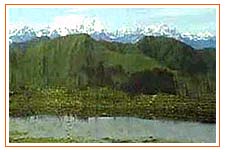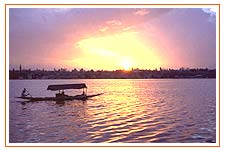
The Himalayas, roof of the world, is a magic place where the magnificence of
the world's highest mountains is mirrored in the rugged beauty and
unique culture of the people who live in their shadow.
Duration: 06 Nights - 07 Days
Duration: 07 Nights - 08 Days
Duration: 08 Nights - 09 Days
Duration: 09 Nights - 10 Days
Duration: 11 Nights - 12 Days
Duration: 05 Nights - 06 Days
About Himalayas
| Region: |
Northern Part Of Indian
Sub-Continent |
| Also Known As: |
Himvan, Himvat, Himachal
And Himadri |
| Famous Peaks: |
Mount Everest,
Kunchenjunga, K2, Nanga Parbat |
Himalayas - The Great Snowy Ranges

In
a memorable verse of the 'Kumarsambhava', the famous Sanskrit poet
Kalidasa compares the Himalaya to a gigantic measuring rod striding the
earth between two oceans. The snow-capped peaks are indeed the most
impressive feature. Himalaya, a Sankrit word, which means ' The Abode Of
Snow' and all other names used to describe this mountain range associate it
with eternal snow - "Himvan", "Himvat", "Himachal"
and "Himadri".
Interestingly, a vast shallow sea, the Tethys, existed where the Himalaya
stands today. The submerged landmasses on either side started pushing
towards each other, giving birth to these mountains. This was a relatively
recent occurrence in the geographical time frame, so the Himalaya is
considered a young and fragile land formation. Scientists speculate that the
whole process took five to seven million years. Fossil finds at heights of
over 8,000 metres (26,000 feet) support these theories. The Himalaya has
risen about 2,000 metres (6,600 feet) in the past 20,000 years and continues
to rise at the rate of 7.5 to 10 centimetres (3-4 inches) a year.
The High And Mighty
The Himalaya
is the world's mightiest mountain range. No other chain can boast of peaks
of 8,000 metres (26,000 feet). In the Himalaya there are 14 such peaks and
hundreds of summits over 7,000 metres (23,000 feet) high. The range of
mountains stretches 2,700-kms (1,700 miles) across an area between Assam and
Kashmir. In the east, Namche Barwa stands sentinel; the western extremity is
guarded by the awesome Nanga Parbat.
Varied Instances
The
snow-capped, frost-crusted peaks have posed a challenge not only to the
physical prowess of adventures; they have also inspired sublime metaphysics
and lyrical poetry. There are innumerable references to this king of
mountains, the glistening divinity, and the noble soul.

The earliest is in the Rig Veda. Singing the praise of the supreme deity,
the poet sages refer to the Himalaya: 'It is to He to whom belong these
celestial mountain ranges.' These sages also describe its stretch as: 'the
expanse of the two arms of the great being'. The epic Ramayana and
Mahabharat, and the Puranas, describe this as the region where the Gods
dwell, and the landscape is evoked beautifully in classical poetical works.
According to the "Skanda Purana" notes: 'As the sun dries the
morning dew so does the mere sight of the Himalaya dissipate the sins of
man.'
Rivers Running Through It!
The Himalaya
is the source of many great rivers of the Indian subcontinent. The Indus or
Sindhu (the river rising out of a lion's mouth) rises in the trans-Himalayan
Tibetan Plateau, as does the Brahmaputra. The Ganga and Yamuna, with their
countless colourful Himalayan tributaries, are inextricably intertwined with
local myths and legends.
Securing The Lands
For
centuries, the Himalaya acted as the bulwark of Indian security, serving as
the great divide between India and Tibet. The rugged terrain deterred all
but the most dauntless from risking their lives on perilous journeys in the
icy heights. But, difficult though many of the passes and valleys were, they
did not prevent a slow penetration by determined and hardy souls for the
purposes of trade and pilgrimage. It must be remembered that the Himalayan
region has also served through history as a melting pot of races, religions
and cultures.
The vast Himalaya is far from being a homogenous region. It is, in fact, a
region of remarkable variety. 'Himachal' (steadfast snows), is the term used
to denote the lesser Himalaya; the outer rim rises sharply from the
foothills, which are called the 'Doars', from the Sanskrit 'Dvar'
(gateway). The greater Himalayas themselves are referred to as the
'Himadri'. ' Uttarakhand' is a loose, general term covering all the northern
territories; it also denotes Kumaon and Garhwal as a unit.
Outlining the North Indian Subcontinent
Although the
Himalaya can be traced to the Arakans and Arunachal in the east, its majesty
is truly encountered only when one reaches Bhutan and Sikkim. The 8,682
metre (28,483-foot)-tall Kanchenjunga overshadows all else in Sikkim. This
beautiful mountain is considered sacred by Hindus and Buddhists alike and
its name translates as the ' Treasure of Five Jewels'. It is the
third-highest mountain in the world.
 Kashmir:
Kashmir:
The beautiful valley of Kashmir and the alpine meadows of Pahalgam and
Gulmarg have been well trodden by travelers for centuries. Jehangir, the
grand Mughal (also spelt as Moghul), was particularly fond of Kashmir and
retired here in the summers to escape the blistering heat of the plains. He
laid out beautifully landscaped gardens like the Nishat and the Shalimar in
an effort to enhance the natural beauty of the land.
Sikkim:
Sikkim is situated to the south of Tibet and east of Nepal. Many of the
most famous mountains in the Himalayas, including the majestic Everest, lie
in Nepal. Neighbouring Bhutan also shares in the grandeur of the Himalayas.
The entire country is a closed basin between two parallel and deeply
intersecting transverse ridges. It is the catchment area of the Tista (also
spelt as Teesta) River and its affluents. After travelling through Sikkim,
the Tista joins river Brahmaputra.
Uttaranchal:
Uttaranchal lies in the central sector of the Himalaya, its boundaries
marked by the Kali River in the east and the river Sutlaj in the west. Once,
third of the land here consists of barren rocks, ridges and wild gorges. The
7,890-metre (25,885-feet) high Nanda Devi is the highest peak here followed
by Kamet, Trishuli and the Panchachuli.
Nanda Devi is the beloved Goddess of the people in Kumaon and Garhwal.
Veteran mountaineers have gone into raptures over this moving sight, which
has been described as 'the white-robed vision hanging from heaven which
pulsates like a star with purity.' Eric Shipton and H W Tilman discovered
the Nanda Devi sanctuary, and were of the view that the scenes of grandeur
there were too visit for human conception.
Himachal Pradesh:
Himachal Pradesh lies further west, and Kinner Kailash in Kinnaur, is the
most famous peak in this region. The Dhauladhar Range may not boast of many
high peaks but it exudes a quaint charm of its own.
Trans Himalayan Region
The trans-
Himalayan region proper is encountered in Ladakh, the northernmost part of
the Indian Himalayas. Before the district of Kargil was carved out of it,
Ladakh was the largest district of India. It is bounded to the north by the
Kunlun and Karakoram mountains and to the south by the Zanskar ranges.
Mountain ranges run parallel to each other in the southeast and the
northwest.
The famous Silk Route passed through Leh, meaning 'oasis', which is the
district headquarters of present-day Ladakh. Until recently, caravans rested
here before and after crossing the dangerous passes. The highest pass
traversed through the Karakoram is at 5,628 metre (18,464 feet). The
confluences of the Indus River and the Shyok, Zanskar, Nubra and the Drass
rivers are in Ladakh. The landscape is almost lunar and the climate
extremely arid. It is here that the Himalaya begins to taper down and merges
into the Hindukush skirting the heartland of Asia.
Nepal:
The Himalayan kingdom of Nepal is today's most popualar Himlayan
destination in the world. Offering something special for everyone. You can
easily combine wildlife safari, river rafting, a small trek to a normal
tour. The distance are not too long and the possibilites are many. It is
also possible to combine a tour to Nepal with a visit to Lahasa, or an
extended over land tour to Tibet. There is no seasonal constraint on
travelling in and through Nepal. Even in December and January, when the
winter is at its severest, there are compensating bright sun and brilliant
views.
Bhutan:
Bhutan, or the land of the Thunder Dragon, the second Himalayan kingdom is
still perhaps the world's most exclusive tourist destination. An unspoiled
country with majestic mountains impressed with a certrain mystique; a unique
cultural heritage preserved intact and with a continuity of many centuries;
an architectural style like no other; a land full of warm hearted and
friendly people.
Tibet:
Tibet is one extraordinary destination, where adventure lurks around every
corner. Its name the "Roof of the World" is not a mere stetment.
The valley bottoms are hiugher than the highest mountains elsewhere.
Adventure on the road is never short on the beautiful Trans-Himalayan drive
of over 970-kms, through the four mountain passes, promising a panoramna of
a cultural and scenic diversity unsurpassable anywhere.






 In
a memorable verse of the 'Kumarsambhava', the famous Sanskrit poet
Kalidasa compares the Himalaya to a gigantic measuring rod striding the
earth between two oceans. The snow-capped peaks are indeed the most
impressive feature. Himalaya, a Sankrit word, which means ' The Abode Of
Snow' and all other names used to describe this mountain range associate it
with eternal snow - "Himvan", "Himvat", "Himachal"
and "Himadri".
In
a memorable verse of the 'Kumarsambhava', the famous Sanskrit poet
Kalidasa compares the Himalaya to a gigantic measuring rod striding the
earth between two oceans. The snow-capped peaks are indeed the most
impressive feature. Himalaya, a Sankrit word, which means ' The Abode Of
Snow' and all other names used to describe this mountain range associate it
with eternal snow - "Himvan", "Himvat", "Himachal"
and "Himadri". 
 Kashmir:
Kashmir:
 Bhutan, or the land of the Thunder Dragon, the second Himalayan kingdom is
still perhaps the world's most exclusive tourist destination. An unspoiled
country with majestic mountains impressed with a certrain mystique; a unique
cultural heritage preserved intact and with a continuity of many centuries;
an architectural style like no other; a land full of warm hearted and
friendly people.
Bhutan, or the land of the Thunder Dragon, the second Himalayan kingdom is
still perhaps the world's most exclusive tourist destination. An unspoiled
country with majestic mountains impressed with a certrain mystique; a unique
cultural heritage preserved intact and with a continuity of many centuries;
an architectural style like no other; a land full of warm hearted and
friendly people.